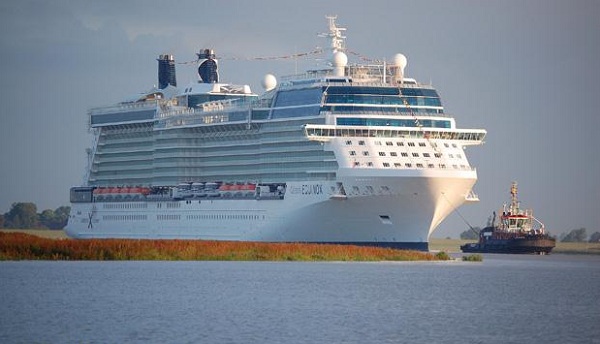The Lower Ems is one of the most heavily modified rivers in Germany. The World Wide Fund for Nature (WWF) now sets up an international and interdisciplinary working group, aiming to assess possibilities to restore natural conditions in the Lower Ems. DHI contributes to the attempted rescue with its modelling capabilities.
Industrial development, river regulation as well as pollution issues profoundly impact the vast majority of Europe’s rivers and associated estuaries. The Lower Ems River, however, has a very special problem: It is being shipped by seagoing cruise vessels, regularly providing spectacular views over Northern Germany’s plains.
| 
Figure caption: Conveyance of the cruise vessel "Celebrity Equinox" on June 20th, 2009.
|
Those vessels are being built in a shipyard approximately 40 km upstream the river mouth. To enable their conveyance to the North Sea, the Lower Ems is subjected to continuous dredging. As a result, within two decades an ecologically intact river mouth was transformed into one of the most heavily modified rivers in Germany - with detrimental effects for the ecosystem and its inhabitants: water quality class dropped by three levels; increased current speed and tidal range resulted in the loss of riverbanks, which are an important habitat for nesting birds and spawning fish; the concentration of suspended mud increased up to 10-fold, clogging the gills of local fish and leading to extremely low oxygen concentrations in summer.
However, the Lower Ems is a patient worth resurrecting. Its floodplains are part of major European bird sanctuaries, and wide parts of the estuary have been classified as a Special Area of Conservation according to the EU’s Natura 2000 directive.
Pooling know-how from various disciplines and countries, WWF together with the public authorities, scientists, engineering companies, environmentalists and developers will look into the prospects for restoring the Lower Ems. The process will take place in close dialogue with Ems-residents from Germany and the Netherlands. DHI is part of the “rescue-team”. As the reduction of suspended sediment loads appears to be a prerequisite for the success of any remediation measure, DHI will supply numerical simulations of hydrodynamics and sediment transport according to different restoration scenarios.
“Modelling the Lower Ems requires cutting-edge technology”, says Florian Ladage from DHI Germany. “That’s due to its complex hydrodynamics with strong tidal asymmetry as well as the highly complicated morphology and sediment dynamics including vast areas covered by fluid mud.”
For now, three different scenarios are being investigated: Two of these look into the restoration of different reaches of the Lower Ems River, using bypassing canals for ship traffic. The third scenario examines a restoration of the river with the help of retention areas in combination with restoring river meanders. Moreover, alternative scenarios like the upstream replacement of the weir are under discussion. All scenarios aim at optimizing the hydraulic regime to reduce tidal pumping and the import of sediment.
“Our aim is to impact hydrodynamics in a way that turbidity is reduced below a critical value”, Ladage explains. “As a result, the local flora and fauna gets a chance to recover and stir the system back into ecological balance.”